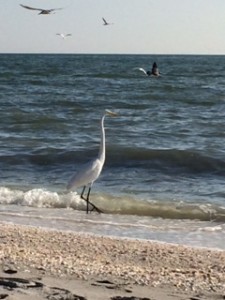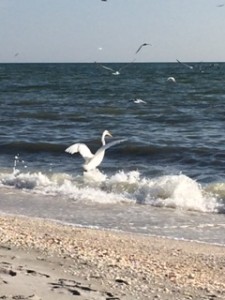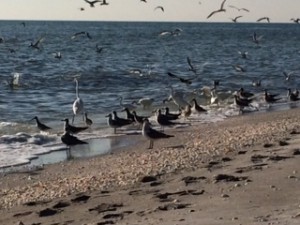Upon arriving to Hawk Mountain, you could tell that it is a popular tourist destination. Immediately as I stepped out of the van I was trampled over by a bunch of young Boy Scouts hastily making their way to the visitor center. By the time I made it to the visitor center it was packed with people every which way you looked. As I walked around the center I was able to learn a lot about the sanctuary, its history and its governing principles and ideals. The mountain used to be a spot where people go together and killed mass amount of raptors, as the public saw raptors as vermin and thought they would cause a great threat to their populations of livestock. In 1934, Rosalie Edge, an advocate for birds of prey bought the mountain and it became a sanctuary to conserve birds of prey. Rosalie saw the importance of raptors to the ecosystem and understood their role as indicators of ecosystem health, as they point out the underlying health of ecosystems. They also benefit farmers and their farmland because they prey on mice, voles and insects. Later, in 1962 Rachel Carson use Hawk Mountain as an example in Silent Spring to raise awareness about birds of prey. In her book she talks about how while sitting up on the North Lookout fewer and fewer eagles were being seen. She emphasized the negative impacts of DDT on the bird populations.
Today, according to the sanctuary, they feel it is important that research, education, training and environmental advocacy are emphasized. These four aspects are evident not only in the visitor center but also while at the North Lookout point. While sitting at the lookout point there was an incredible atmosphere. With everyone working together, people sharing equipment and the usuals helping the newcomers, it was a great environment to be in. There were people off all different backgrounds. One side of the mountain was occupied by clearly more experienced watchers, people from the sanctuary who were keeping the official bird count, and people who are at home citizen scientists. On the other side there was a mix but mostly everyday people taking day trips up to the mountain wanting to learn about birds of prey. While sitting on the mountain as people would see birds they would yell out the location, high or low and what type it was, allowing everyone to learn and experience. However, it was clear while up at north lookout point that Hawk Mountain is a tourist destination and it was definitely not an experience of solitude and reflection, as there were people every which way you looked.
We ended our time at Hawk Mountain with a showing of a golden eagle from a local educational center. As soon as the bird handler removed the eagle from the van the whole crowd gasped, it was beautiful. As the handler chauffeured the eagle to the front of the crowd, every single person (except the members of our class) took out their phones and cameras to snap photos the magnificent creature. The whole time the bird was in front of the crowd, it was clear that it was anxious. As the bird was perched in front on the handler’s arm, it let out an uncomfortable groan, and it did not stop. For 20 minutes straight. As they opened the discussion up for questions, the crowd was so curious, asking so many questions that they had to cut the session off and not everyone got to ask their questions. It was really nice to see how curious all the people there are about birds of prey and educating themselves. Although the presence of the golden eagle did provide an element of education that I didn’t get from sitting on the north lookout, it was at the same time a very sad experience. It was clear that the bird was uncomfortable and had had enough. The handler noticed the bird was starting to get antsy and needed to go back in the van, but he gave us a couple more minutes to get some last minute pictures of the bird’s wing span- and not but a few minutes later did the bird jump off the arm of the handler and head straight for a woman’s head.
Fast forward just one hour and there I was standing among hundreds of animals, ranging from everyday animals like deer and raccoons to polar bears and elephants. All dead. All stuffed. It was quite the opposite experience from Hawk Mountain. As I stood next to the huge mountain in the middle of the store I examined the taxidermy. When you look at each individual animal there is a plaque in front of it that says the specie name, who ‘took’ them and where they were taken. It is an understatement to say that I felt a little bit out of place, “Hi, my name is Jackie Cirincione, I have been a vegetarian for about 5 years and grew up in a household that rehabilitated wildlife.”
I continued walking and I arrived in a room called Deer Country where there are hundreds of deer packed into one room. Hanging on the walls are the ‘world record breaking deer.’ On each individual plaque that hang on the there is a description that glorifies the best deer that have ever been killed and a news article about the killing and who did it. As a stand there it was very interesting to me to hear the people talking about all the different types of deer. Listening to a father explain to his son the types of deer, their defining characteristics etc. Continuing on my journey through the store, I encountered the Africa section where they have zebra, hippopotamuses, elephants etc. all displayed. Next to the elephant there is a photo of Cabela himself next to the dead elephant with the location of where in Africa he was when he killed the elephant. While I was in each of these exhibits the interactions between the consumers and the exhibits was fascinating. I saw many people taking selfies with the animals. One little girl and her mother took a selfie in front of the elephant and when the were looking at it daughter said to her mom, “It’s cool because it looks like we were in the jungle!”
Cabela’s is truly an experience, between the taxidermy displays, the interactive games, the restaurants and the gift shop. However, at the end of the day it is a retail store that sells hunting, fishing and camping supplies. There are plenty of everyday household goods to buy but almost all of them have a connection with hunting. For example you can find couches (in a camouflage design), chandeliers (made of deer antlers), seat covers for your car (in a camouflage design) etc. While browsing the racks you can see popular clothing brands like The North Face and under armor but with a Cabela’s twist. I would go as far to say that at least 80% of the apparel, gear and household items come in a green camouflage for men and a pink camouflage design for women. Whether it’s a fleece jacket, Philadelphia Eagles apparel or car mats they all have the pink option. No one who is actually going to go out to hunt is going to wear pink to camouflage themselves, perhaps Cabela’s is contributing to a whole other conversation about gender and gender roles. Additionally, they also have a bunch of products that I have never seen before, such as a game strap (which comfortably holds 23 birds).They have a product there called ‘Gulp! Alive!’ which is a mimic of an actual fish. The fish you can buy is a natural presentation of a real fish in action, scent and taste and it lives longer and is more durable than a real fish.
Like I said before, the atmosphere at Cabela’s is much more than just a store, they create an experience. Not only do they have their merchandise for sale but they also provide customers with displays, interactive games and exhibits, restaurants, a gift shop. You don’t plan to just run into Cabela’s and just grab something, you plan to stay for a few hours. Although I did not particularly enjoy my experiences at Cabela’s I did learn a lot and it did cause me to think from another perspective and think about the different cultures of nature. After my visit I concluded that I do think that there is a value in taxidermy, in the form of educational experiences. A person can learn a lot about an animal from seeing it in person and being able to visually explore. However at Cabela’s I found the amount of taxidermy to be excessive and not used for an educational purpose. I felt like that the taxidermy and the atmosphere and experiences in the store were there to emphasize the thrill of the game and the desire to kill for the take home trophy. I felt similarly with the way in which they define nature. In Cabela’s nature can be seen as a trophy, a sport and a game. At this store man dominates nature, “it’s in your nature” is their slogan. Many of the consumers at Cabela’s are people who are going there to buy guns which they will use to kill and catch their own food, people who find nature to be a commodity and something that they should be using. What it comes down to between me, and I can assume the people Hawk Mountain, having different values of nature than the people who shop at Cabela’s. Who is to say that my values are right and theirs aren’t? I know that I will never agree or find value in killing for the take home trophy or killing for my own food but after this field trip my eyes were opened to a different lifestyle and set of values that I can do nothing but acknowledge and understand as a reality in our country.

 This is a picture of a snowy egret (if it’s feet weren’t in the water you would be able to identify it by its yellow feet):
This is a picture of a snowy egret (if it’s feet weren’t in the water you would be able to identify it by its yellow feet):
